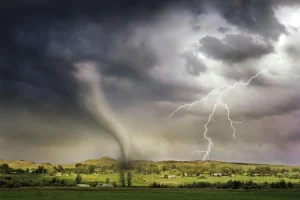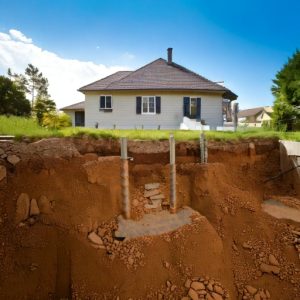Foundations face challenges worldwide, but the specific issues vary depending on climate, soil type, and geography. From arid deserts to humid tropics, these environmental factors can directly impact how foundations perform and deteriorate over time. Here, we’ll explore some of the unique challenges faced by foundations across the globe and take a closer look at how the soil in Lawrence, KS, presents its own set of difficulties.
Global Challenges to Foundation Stability
1. Expansive Clay Soils
In regions like the southern United States, Africa, and parts of Australia, expansive clay soils pose a significant threat to foundations. These soils swell when wet and shrink when dry, causing constant movement that can crack or destabilize foundations.
2. High Water Tables
In coastal or low-lying areas, such as parts of Southeast Asia and the Netherlands, high water tables can lead to water infiltration and hydrostatic pressure. Over time, this water pressure can weaken foundation walls and cause shifting.
3. Freeze-Thaw Cycles
Cold climates, like those in Canada, Scandinavia, and parts of the northern United States, experience repeated freeze-thaw cycles. Water in the soil freezes and expands, exerting pressure on foundations and leading to frost heave, which can cause cracks and uneven settling.
4. Seismic Activity
In areas near fault lines, like Japan, California, and Turkey, earthquakes create sudden ground movement that can cause catastrophic foundation failures. Special construction techniques, like shock-absorbing piers, are often necessary in these regions.
5. Arid Environments
Deserts, such as those in the Middle East or southwestern United States, often have dry, sandy soils that can lead to erosion and foundation settling. The lack of moisture causes loose, shifting ground beneath the structure.
Unique Challenges in Lawrence, KS
Lawrence, KS, sits in an area with soils that present a unique mix of challenges, primarily due to the prevalence of expansive clay soils and seasonal weather patterns.
1. Expansive Clay Soil
Like much of Kansas, Lawrence is known for its expansive clay-rich soil, particularly a type referred to as smectite clay. This soil absorbs water like a sponge during wet periods, swelling and exerting pressure on foundations. During dry spells, the soil contracts, leaving voids beneath the foundation that can lead to settling or cracks.
2. Seasonal Extremes
Kansas experiences a wide range of weather extremes—from heavy spring rains to scorching summer droughts and freezing winter temperatures. These shifts exacerbate soil movement, putting additional stress on foundations. The frequent alternation between wet and dry conditions makes maintaining proper drainage and moisture control critical for homes in Lawrence.
3. Flood Risks
Parts of Lawrence are located near rivers and streams, making some areas prone to occasional flooding. Excess water can saturate the soil, weaken its stability, and increase hydrostatic pressure on basement walls, potentially causing bowing or cracks.
How Different Climates Inform Foundation Strategies
Drainage and Moisture Control
Across the globe, controlling moisture around the foundation is crucial. In Lawrence, KS, installing proper gutters, downspouts, and drainage systems can prevent water from pooling near the foundation, reducing the risk of soil expansion and hydrostatic pressure.
Foundation Reinforcement
In earthquake-prone areas, foundations are often designed with flexible or reinforced materials to absorb seismic shocks. In Lawrence, reinforced concrete and piering systems are commonly used to counteract the effects of expansive clay soil.
Adaptable Design
Homes in flood-prone regions often use elevated foundations or waterproofed basements. Similarly, in Lawrence, sealing cracks and maintaining sump pumps can mitigate the impact of heavy rains and potential flooding.
Routine Maintenance
Regular inspections and proactive maintenance are universal strategies. Homeowners in Lawrence, KS, should watch for signs of foundation stress, such as cracks or uneven floors, particularly following extreme weather events.
Lessons from Around the World for Lawrence Homeowners
- Stay Proactive: In regions with expansive clay soils, including Lawrence, keeping the soil consistently moist during droughts can prevent extreme shrinking. Watering the soil around your home (but not too close to the foundation) during dry spells can reduce movement.
- Invest in Drainage Solutions: Inspired by strategies used in flood-prone regions, ensure that water flows away from your foundation with proper grading, French drains, and downspouts.
- Monitor Seasonal Changes: Just as homeowners in freeze-thaw regions must watch for frost heave, Lawrence residents should monitor foundation stress after wet springs and dry summers. Seasonal maintenance can prevent minor issues from becoming major repairs.
- Adapt with Modern Techniques: Borrowing from areas facing seismic activity, consider advanced stabilization systems like steel piers, which are particularly effective against settling caused by clay soils.
Conclusion
Foundation problems may differ across climates and geographies, but the need for proactive care and repair is universal. In Lawrence, KS, the combination of expansive clay soils and fluctuating weather conditions requires special attention to moisture control, drainage, and regular maintenance. By learning from the challenges faced in other parts of the world, homeowners can better protect their foundations and ensure the stability of their homes for years to come.






